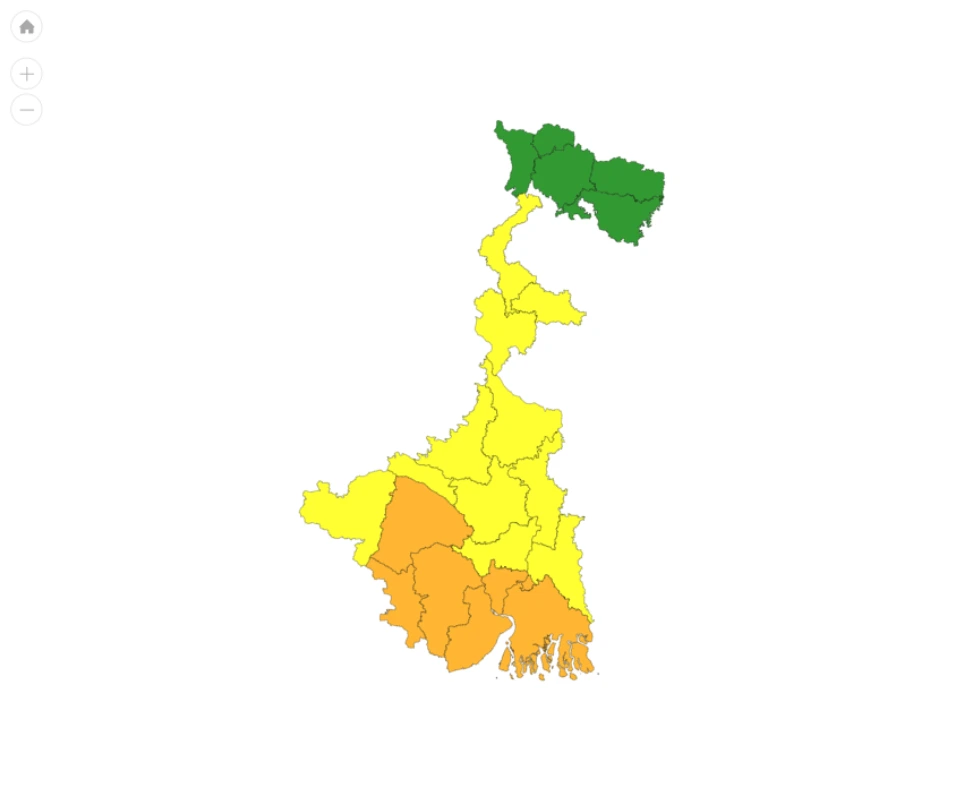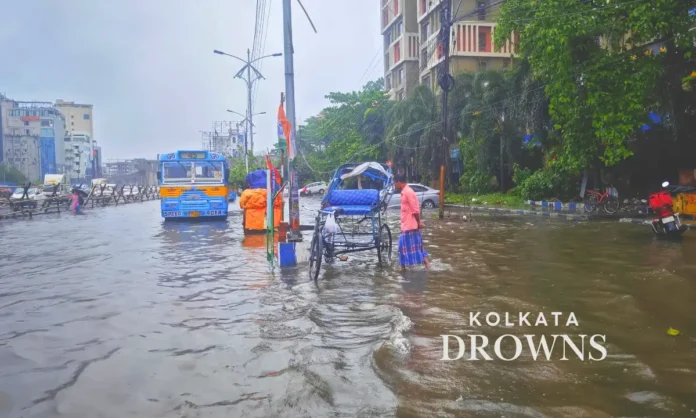Key Highlights:
- Kolkata received 247.4 mm rainfall in 24 hours, surpassing 22 days of September precipitation combined
- Seven people died from electrocution as unprecedented downpour flooded streets and homes across the city
- IMD data shows the city experienced 2,663% more rainfall than normal 24-hour averages during the deluge
Opening Overview
The devastating flooding that paralyzed Kolkata on September 22, 2025, represents an extraordinary meteorological event that exposed the vulnerabilities of India’s third-largest city. Between midnight and 6 AM alone, exceptional rainfall transformed the City of Joy into a waterlogged nightmare, with some areas recording over 295 mm of precipitation in just six hours. This Kolkata flooding crisis demonstrates how climate extremes can overwhelm even established urban infrastructure, as the city received more rain in a single night than it typically sees across three weeks of September.
The scale of this Kolkata flooding emergency becomes clear when examining official meteorological data released by the India Meteorological Department. From September 1-22, the city had received 178.6 mm of rainfall, which was actually 16% below the normal 213.7 mm expected for this period. However, the 24-hour period ending at 8:30 AM on September 23 brought 247.4 mm of rain, effectively delivering more precipitation than the preceding 22 days combined. This unprecedented deluge triggered widespread Kolkata flooding that claimed seven lives and brought normal life to a complete standstill.
The timing of this Kolkata flooding catastrophe proved particularly problematic, occurring just days before the city’s annual Durga Puja festival. Major arterial roads including Park Circus, Gariahat, Behala, and College Street became impassable waterways, with vehicles stranded in knee-to-waist-deep water for hours. The city’s already vulnerable drainage infrastructure, much of which dates back over a century, simply could not cope with the sudden influx of water.
Weather Forecast and Warnings: East & Central India
— India Meteorological Department (@Indiametdept) September 22, 2025
Although the sky may grow gloomy from September 22 to 27, IMD's forecasts provide insight into safety. pic.twitter.com/7gRmAGL7DV
Unprecedented Meteorological Crisis
The meteorological data surrounding this Kolkata flooding event reveals just how exceptional the rainfall was in both intensity and duration. According to IMD statistics, Kolkata received 2,663% more rainfall in the critical 24-hour period than the long-term average, making it one of the most extreme precipitation events in the city’s recorded history. The neighboring Howrah district experienced 1,006% more rainfall than average, while North 24 Parganas recorded 857% above normal levels.
Kolkata Municipal Corporation’s rain gauge data provides granular insights into how this Kolkata flooding developed across different neighborhoods. Ballygunge emerged as the worst-hit area with 295 mm of rainfall, followed closely by Mukundapur at 280 mm, Gariahat at 262 mm, and Jadavpur at 258 mm. Even Alipore, traditionally one of the city’s better-drained areas, recorded 240 mm of precipitation. These figures underscore how the Kolkata flooding affected virtually every corner of the metropolitan area simultaneously.

The meteorological cause behind this Kolkata flooding crisis stems from a low-pressure area that developed over the northeast Bay of Bengal. This weather system brought intense rainfall to coastal areas of Gangetic West Bengal, including Kolkata, Hooghly, and Howrah districts. Weather forecasters warned that this low-pressure system would persist for at least 24 additional hours, raising concerns about continued Kolkata flooding risks. The concentrated nature of the rainfall, with most precipitation falling between midnight and 6 AM, overwhelmed the city’s drainage capacity before authorities could implement effective response measures.
Infrastructure Breakdown and Human Impact
The human cost of this Kolkata flooding tragedy became evident as seven people lost their lives, primarily due to electrocution caused by water contact with electrical installations. Kolkata Mayor Firhad Hakim confirmed these fatalities while noting that municipal teams were working around the clock to drain accumulated water from affected areas. The mayor warned that high tide conditions around 1:30 PM could further complicate drainage efforts, potentially extending the Kolkata flooding crisis well into the evening.
Transportation systems across the city collapsed under the impact of the Kolkata flooding, with Metro services, suburban trains, and bus operations suspended indefinitely. The paralysis of public transport left thousands of commuters stranded, while private vehicles abandoned on flooded roads created additional obstacles for emergency responders. Educational institutions across the city declared holidays, and many businesses remained closed as employees could not reach their workplaces through the Kolkata flooding.
The timing of this Kolkata flooding catastrophe proved particularly challenging for the city’s festival preparations, as Durga Puja pandals in low-lying areas became submerged. Organizers faced the dual challenge of protecting elaborate decorations while ensuring visitor safety in areas prone to waterlogging. The economic impact extended beyond immediate flood damage, as disrupted supply chains and closed businesses threatened to affect the festival economy that generates significant revenue for the city.
Emergency response efforts revealed both the dedication of municipal workers and the limitations of existing Kolkata flooding preparedness measures. KMC teams deployed across the city found that traditional drainage methods proved inadequate against the sheer volume of water. The mayor’s assessment that normalcy would require at least 12 hours highlighted how even well-coordinated response efforts struggle against extreme weather events of this magnitude.
Systemic Drainage Deficiencies
The severity of this Kolkata flooding crisis exposed long-standing infrastructure deficiencies that experts have warned about for years. A 2022 UN climate science report specifically identified Kolkata’s drainage system as inadequate, describing its management as “an immense challenge.” The Intergovernmental Panel for Climate Change noted that much of the city’s drainage infrastructure is over a century old and lacks the capacity to serve current population needs.
Structural problems contributing to Kolkata flooding include the absence of underground sewer systems in most parts of the Kolkata Metropolitan Area, leaving drainage dependent on surface channels that become easily blocked by solid waste. Plastic pollution particularly affects drainage efficiency, while outflow canals frequently become silted, covered with water hyacinth, or encroached upon by illegal constructions. These systemic issues mean that even moderate rainfall can trigger localized Kolkata flooding in vulnerable neighborhoods.
The loss of natural drainage resources has exacerbated Kolkata flooding vulnerabilities over recent decades. Environmental experts point to the systematic destruction of the East Kolkata Wetlands, which traditionally served as natural flood buffers for the city. Urban development has eliminated crucial “blue infrastructure” including water bodies, lake systems, and wetlands that historically absorbed excess rainfall. This reduction in natural sponges means that precipitation now creates immediate runoff rather than being gradually absorbed into the ecosystem.
Recent infrastructure investments have shown mixed results in addressing Kolkata flooding challenges. A £32 million sewer repair project successfully refurbished 130-year-old sewers using glass reinforced polymer lining, which increased flow capacity and reduced friction. However, the September 2025 flooding demonstrates that even upgraded systems can be overwhelmed by extreme precipitation events. The city has also installed additional pumping stations and undertaken canal dredging projects, but these improvements require continuous maintenance and expansion to match growing climate risks.
Climate Change and Urban Planning Implications
The September 2025 Kolkata flooding represents a stark example of how climate change is intensifying urban flood risks across India. Expert analysis indicates that such extreme precipitation events are becoming more frequent and severe due to changing weather patterns in the Bay of Bengal region. The concentration of intense rainfall into shorter time periods creates challenges that traditional drainage systems, designed for more gradual precipitation patterns, cannot handle effectively.
Urban planning decisions have significantly amplified Kolkata flooding vulnerabilities through decades of development that ignored natural drainage patterns. The concretization of natural drainage channels and encroachment on floodplains has reduced the city’s capacity to absorb sudden rainfall. Similar to other Indian cities like Bengaluru, which has lost over 80% of its natural lakes, Kolkata has seen systematic reduction in water retention areas that historically prevented severe flooding.
The economic implications of recurring Kolkata flooding extend far beyond immediate damage costs to include long-term development challenges. Flood-prone areas experience reduced property values, deterred investment, and increased insurance costs that collectively hamper economic growth. The disruption of business operations during flood events creates ripple effects throughout supply chains, while the psychological impact on residents affects quality of life and city attractiveness for skilled workers.
Future-proofing against Kolkata flooding requires comprehensive approaches that integrate climate adaptation with urban development planning. Experts recommend implementing “sponge city” principles that prioritize water absorption through green infrastructure, restored wetlands, and permeable surfaces. The protection and enhancement of remaining natural water bodies becomes crucial for maintaining the city’s ecological resilience against extreme weather events. Additionally, updating building codes and zoning regulations to account for increased flood risks can help minimize future damage from similar Kolkata flooding events.
Closing Assessment
The devastating Kolkata flooding of September 2025 serves as a powerful reminder of how climate extremes can overwhelm even major metropolitan areas in a matter of hours. The unprecedented nature of receiving 247.4 mm of rainfall in 24 hours, compared to just 178.6 mm over the previous 22 days, demonstrates the increasing unpredictability of weather patterns that cities must now prepare for. This event killed seven people and paralyzed a city of millions, highlighting the urgent need for comprehensive flood management strategies that can respond to such extreme scenarios.
The infrastructure limitations exposed by this Kolkata flooding crisis reflect broader challenges facing Indian cities as they grapple with aging drainage systems and rapid urbanization. While recent investments in sewer rehabilitation and pumping capacity represent positive steps, the September deluge proved that even upgraded systems require continuous expansion to match evolving climate risks. The systematic loss of natural flood buffers like wetlands and water bodies has left cities increasingly vulnerable to the type of concentrated precipitation that triggered this disaster.
Looking ahead, the lessons from this Kolkata flooding catastrophe must inform both immediate response capabilities and long-term urban planning strategies. The city’s experience demonstrates that effective flood management requires not just engineering solutions but also ecosystem restoration and climate-adaptive development policies. As extreme weather events become more frequent, cities like Kolkata must balance protecting existing infrastructure with building resilience for an uncertain climatic future.


